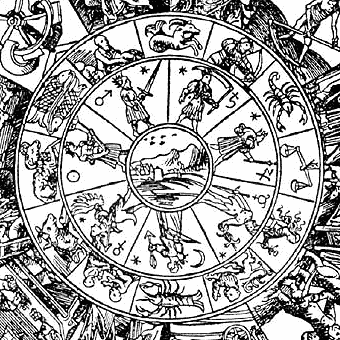Zodiac
(Difference between revisions)
Categories: Astrology | Astrological terms
|
Revision as of 14:15, 5 Nov 2004 Ash (Talk | contribs) |
Current revision RIKB (Talk | contribs) |
||
| Line 5: | Line 5: | ||
| ==The Tropical and Sidereal Zodiacs== | ==The Tropical and Sidereal Zodiacs== | ||
| - | About two millennia ago, these signs lined up neatly with the constellations of the same names. However, thanks to the [[precession of the equinoxes]], the signs have moved about 25° west with respect to the fixed stars. For example, the Sun enters the sign of Aries (by definition) at the Vernal [[Equinox]], on approximately March 20, but does not enter the ''constellation'' of Aries—the pattern of fixed stars with that name—until roughly April 14. Because it is tied to the seasons rather than the stars, the conventional Western zodiac is also called the "tropical" zodiac (the sun moves between the Tropics of Cancer and Capricorn at the equinoces). | + | About two millennia ago, these signs lined up neatly with the [[constellation]]s of the same names. However, thanks to the [[precession of the equinoxes]], the signs have moved about 25° west with respect to the [[fixed stars]]. For example, the Sun enters the sign of [[Aries]] (by definition) at the Vernal [[Equinox]], on approximately March 20, but does not enter the ''constellation'' of Aries—the pattern of fixed stars with that name—until roughly April 14. Because it is tied to the seasons rather than the stars, the conventional Western zodiac is also called the "tropical" zodiac (the sun moves between the Tropics of Cancer and Capricorn at the equinoces). |
| Some Western astrologers use an alternative zodiac which is fixed relative to the stars rather than the seasons. This "sidereal" zodiac drifts further out of alignment with the tropical zodiac by about a degree every 72 years. Unlike in the tropical zodiac, in the sideral zodiac the vernal point moves from sign to sign as precession occurs; currently it is in the westernmost part of sidereal Pisces, and moving steadily further westward. In about three and a half centuries, it will cross into sidereal Aquarius; this is what is meant by the "Age of Aquarius", and incidentally why we are said to be in "the dawning" of that age rather than the age itself. | Some Western astrologers use an alternative zodiac which is fixed relative to the stars rather than the seasons. This "sidereal" zodiac drifts further out of alignment with the tropical zodiac by about a degree every 72 years. Unlike in the tropical zodiac, in the sideral zodiac the vernal point moves from sign to sign as precession occurs; currently it is in the westernmost part of sidereal Pisces, and moving steadily further westward. In about three and a half centuries, it will cross into sidereal Aquarius; this is what is meant by the "Age of Aquarius", and incidentally why we are said to be in "the dawning" of that age rather than the age itself. | ||
Current revision
In Western astrology, 12 such signs are recognized, each occupying a 30° segment of ecliptic longitude. Starting with the vernal point and moving eastward, these are: Aries, Taurus, Gemini, Cancer, Leo, Virgo, Libra, Scorpio, Sagittarius, Capricorn, Aquarius, and Pisces.
| Table of contents |
The Tropical and Sidereal Zodiacs
About two millennia ago, these signs lined up neatly with the constellations of the same names. However, thanks to the precession of the equinoxes, the signs have moved about 25° west with respect to the fixed stars. For example, the Sun enters the sign of Aries (by definition) at the Vernal Equinox, on approximately March 20, but does not enter the constellation of Aries—the pattern of fixed stars with that name—until roughly April 14. Because it is tied to the seasons rather than the stars, the conventional Western zodiac is also called the "tropical" zodiac (the sun moves between the Tropics of Cancer and Capricorn at the equinoces).
Some Western astrologers use an alternative zodiac which is fixed relative to the stars rather than the seasons. This "sidereal" zodiac drifts further out of alignment with the tropical zodiac by about a degree every 72 years. Unlike in the tropical zodiac, in the sideral zodiac the vernal point moves from sign to sign as precession occurs; currently it is in the westernmost part of sidereal Pisces, and moving steadily further westward. In about three and a half centuries, it will cross into sidereal Aquarius; this is what is meant by the "Age of Aquarius", and incidentally why we are said to be in "the dawning" of that age rather than the age itself.
General meaning
- Aries—"I want," action oriented, pioneering, assertive, enthusiasm, competitive
- Taurus—"I have," sensual, cautious, stubborn, physical
- Gemini—"I think," curious, talkative, sociable, duality, mercurial, intelligent
- Cancer—"I feel," sensitive, tenacious, family and home oriented, helpful, nurturing, moody
- Leo— "I am," passionate, dramatic, independent, noble, leader, egotistical, selfish
- Virgo—"I serve," practical, analytical, work and service oriented, critical, common sense, orderly
- Libra—"We are," partnerships, balance, grace, charm, cooperative, social, ideas, lazy, kidneys/lumbar
- Scorpio—"I desire," intense, controlling, sexual, compulsive, deep, secretive, mysterious, obsessive
- Sagittarius—"I seek," philosophic, fun-loving, adventurous, blundering, wanderlust, scattered
- Capricorn—"I build," ambitious, cautious, authoritative, cunning, competent, stable, saturnine
- Aquarius—"I know," friendships, cause-oriented, the group, society, progressive, eccentric, aloof
- Pisces—"I believe," feeling, duality, spirituality, soul growth, suffering, artistic, overly emotional
Other Zodiacs
Nearly every culture has an astrological system of one kind or another. Many of those of the Old World are noticeably related thanks to centuries of cultural diffusion; for example, the European system shows clear borrowings from Egyptian, Persian, and Indian lore. Interestingly, both the Mayan and some Hindu systems are sidereal rather than tropical; indeed, the word "ayanamsa" is borrowed from the Hindu Vedic system to name the angular difference at any given time between the sidereal and tropical coordinate systems.
See also
![[Main Page]](http://www.thelemapedia.org/images/logo.gif)
